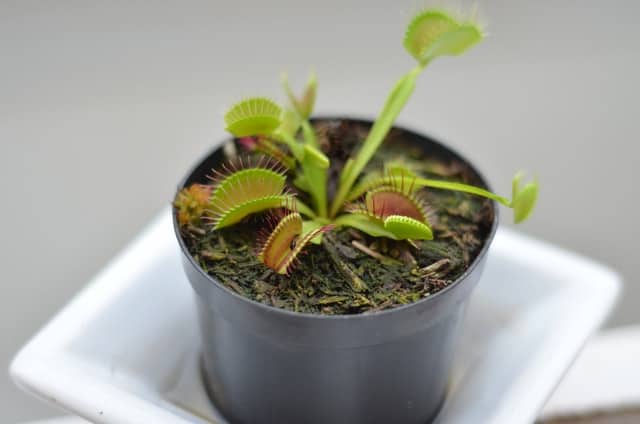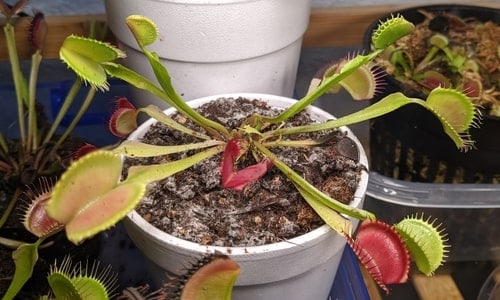Watering Venus flytraps appropriately can be a challenge as Venus flytraps need precise watering and humidity levels to remain healthy.
Venus flytraps need to be watered every 2 to 4 days, depending on the season. The soil must be humid at all times but not flooded or soggy.
One way to water your Venus fly trap perfectly every time is by using the water tray method. Place the plant pot in a tray and fill up the tray with 1-2 inches of water. Let the plant consume the water and refill as soon as the tray dries out.
Important Note: Never employ tap water or bottled water as these can be very harmful for Venus fly traps. Always water your plant with pure water, such as distilled, reverse osmosis, or rainwater.
For many, it is a challenge to find the perfect balance of how much water do Venus flytraps need. This article will teach you how much to water a Venus flytrap to avoid overwatering and underwatering.
How Much Water Does a Venus Flytrap Need?
Venus flytraps are native to South Carolina and North Carolina in the United States. In the wild, they are exposed to high humidity levels year-round and plenty of rainfall. When growing Venus flytraps at home, you must try to replicate its native habitat, including the watering frequency.
Venus flytraps require an above average amount of water. They must be water often and thoroughly until the soil is moist all around. Then, there is no need to water until the soil is slightly less humid.
After watering a Venus flytrap, you should be able to press the soil and sense the humidity throughout without it being soaked.
The specific watering frequency varies greatly with different environmental conditions. For that reason, testing the humidity in the soil by pressing on it is a better strategy.
I live in an area with extremely hot summers (110 F+). During the summer months, I water my plants almost every day. But, in more mild weather or indoors, you might only need to water your plant a couple of times a week.
Overwatering and underwatering Venus flytraps is dangerous for the health of the plant as they cause root rot or even death.
- Signs of overwatering: Presence of algae or white mold in the soil
- Signs of underwatering: Droopy and dried up leaves
Besides water your fly trap correctly, it is key that you employ suitable soil. Here is a guide that lists the best soil options .
.
The Water Tray Method
The water tray method is extremely useful for watering carnivorous plants. It allows you to water your plant the exact right amount and keep your Venus flytraps healthy.
The water tray method is optimal for Venus flytraps. Here is how it works:
- Obtain a shallow plastic or glazed ceramic tray
- Place your plant’s pot inside the water tray
- Fill the water tray with pure water (distilled water, reverse osmosis water, or rainwater) until it reaches 1-2 inches in depth
- Refill the water as soon as the tray dries up.

Employing the water tray method will ensure the soil for your Venus flytrap remains humid but never exceeds the required humidity. Also, it is advantageous to hold a small water reserve, which gives you more flexibility.
I refill the trays for my Venus flytraps once or twice a week. If I am out of town for a few days, it is safe to leave them with a tray full of water.
This method requires a pot with drainage. Consider repotting your plant if their pot lack drainage. It is challenging to grow Venus flytraps without drainage holes.
Watering From the Bottom vs Top
With the water tray method, plants are watered from the bottom rather than the top. Watering from the top is the most common practice, and it is suitable for Venus flytraps. However, it tends to be more challenging as it is difficult to find the perfect balance.
Watering from the bottom is a popular strategy among carnivorous plant owners as it prevents overwatering and promotes root growth. The roots of the plant are encouraged to grow and have easier access to the tray water.
There are some variations of the water tray method depending on the type of soil employed and your plant’s life stage. The next sections will expand on these subjects.
Watering Different Types of Soil
Different soil composition requires changes in the watering frequency. Some Venus flytrap owners employ pure moss, either peat or long-fibered sphagnum moss. Others use a mixture of moss with a drainage and aeration agent, such as sand and perlite.
There is no exact rule of how much water to employ for each soil type, but here is some advice:
- When employing potting media of pure moss, pay close attention to the watering levels to avoid overwatering. Pure moss tends to retain water and does not offer optimal drainage.
- A combination of moss and sand or perlite is optimal for Venus flytraps. Still, always test the soil after watering. Make sure it is always humid but not muddy. The sand or perlite will help keep excessive moisture away from the roots.
Watering Level Changes Through Venus Flytrap Life Stages
As Venus flytraps develop, their watering requirements change. Also, you will need to adjust the watering frequency for different seasons.
The list below includes specific considerations for watering Venus flytraps at a particular growth cycle.
- Seeds: Venus flytraps need very high humidity to germinate. They sometimes require a closed container with plenty of water and a high humidity index. When watering seeds, do not drown them. But, add a higher amount of water than usual. The soil must be saturated with water. A dry environment can kill them, and since seeds do not have roots yet, there is no risk of root rot from overwatering.
- Leaf-cutting or pullings: Propagating Venus flytraps requires a very humid environment. Just like seeds, make sure the soil remains very humid. Overwatering is preferred from underwatering. The ground can be soggy during this stage.
- Seedlings: Once a Venus flytrap has developed from seeds or leaf cuttings, it does not need excessive moisture. It requires humid but not soggy environments.
- Young/ Adult Venus flytraps: Keep the soil humid at all times, but avoid flooding it and letting it dry out.
Throughout the year, Venus flytraps might consume more or less water. For example, during the growing season, Venus flytraps increase their water consumption. Also, the hot weather tends to evaporate some of the water.
When Venus flytraps go dormant, their watering consumption will lower noticeably. This is not an issue, but just a seasonal change.
Overwatering vs Underwatering a Venus Flytrap
Both overwatering and underwatering are harmful to Venus flytraps. They can weaken the plant and eventually kill it.
Underwatering a Venus flytrap will weaken it substantially. The plant will start looking down or droopy (read article on how to fix droopy Venus Flytraps). And the leaves will begin drying up. If the soil dries up completely, the plant can dry up with it and die. A plant won’t recover if the bulb dries up.
Overwatering a Venus flytrap is also very harmful. A few signs can help us determine if a plan has been overwatered. First, they might develop a layer of white mold in the soil. The mold won’t kill the plant, but it is a sign of excessive moisture. Also, algae developing on the water tray is a sign of excessive humidity without enough sunlight.

You can eliminate white mold from your plant by following the instructions in this article .
.
Venus flytraps can develop root rot when they are overwatered. Root rot is a serious condition; it eats up the plant roots and ultimately kills it. Luckily, it is possible to save a Venus flytrap suffering from root rot (here is how you solve it). The video below outlines the steps:
As you learned, there are adverse effects for both underwatering and overwatering. Adjust the watering frequency for your Venus flytrap accordingly. To ensure success, employ a pot with drainage and preferably choose a soil with enough aeration and drainage (Venus Flytrap Soil Guide).
Generally, underwatering can kill Venus flytraps a lot faster than overwatering. For that reason, when in doubt, I would recommend more water rather than less.
The watering process for Venus flytraps is critical to keep them thriving. But, many other factors can greatly affect these beautiful and unique plants. For all additional Venus flytrap care information, you can read this article: Ultimate Venus Flytrap Care Guide – Free Care Sheet Included .
.
You have learned how often to water a Venus flytrap, but other factors also affect the watering process. For your reference, this article contains a complete guide!
contains a complete guide!
Recommended Products for Growing Carnivorous Plants
Finding the best pots, lights, and soil for carnivorous plants is difficult. I have grown carnivorous plants for over 5 years, and these are the products I use. The links will take you to Amazon to view the prices and full specs:
- Carnivorous Plant Soil
- Carnivorous plant soil: https://amzn.to/422yLZa

- Carnivorous plant soil: https://amzn.to/422yLZa
- Artificial Lighting
- Small plant light for 1-2 plants: https://amzn.to/3oQsmSj

- T8 LED light fixture for multiple plants (6500k Cool White): https://amzn.to/3uWoeh2

- Small plant light for 1-2 plants: https://amzn.to/3oQsmSj
- Pots and Miscellaneus
- Nursery pots for single plants: https://amzn.to/3oL8YGq

- Nursery pots for single plants: https://amzn.to/3oL8YGq
- TDS meter to measure water quality: https://amzn.to/3g8VKLI

- Dried crickets to feed carnivorous plants: https://amzn.to/34QEnKv

Best of luck growing Venus flytraps and have fun!
